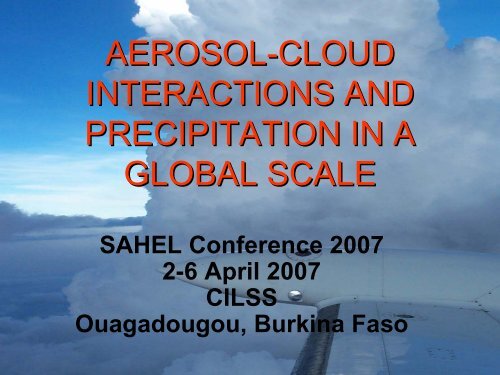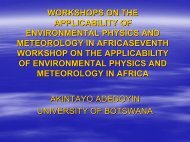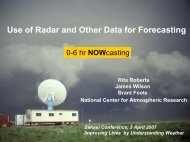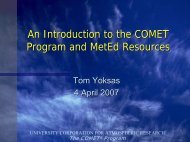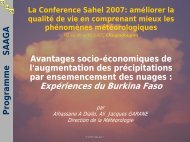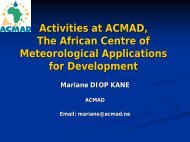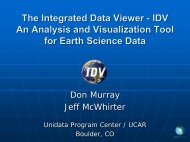Aerosol - Cloud Interactions and Precipitation in a Global Scale
Aerosol - Cloud Interactions and Precipitation in a Global Scale
Aerosol - Cloud Interactions and Precipitation in a Global Scale
- No tags were found...
You also want an ePaper? Increase the reach of your titles
YUMPU automatically turns print PDFs into web optimized ePapers that Google loves.
The aerosol/precipitationconnection• <strong>Aerosol</strong> environment has changed– CCN/sulfates are about 70% anthropogenic with strongvariation <strong>in</strong> emissions geographically– Desert dust concentrations vary widely; appear to beimportant IN• Clear anthropogenic effects(e.g., satellite evidence)• Well known climate connections– Direct (reflect <strong>in</strong>com<strong>in</strong>g solar radiation back to space)– Indirect (modify properties <strong>and</strong> lifetime of clouds)• L<strong>in</strong>kage to precip understood <strong>in</strong> pr<strong>in</strong>ciple, but hardevidence is scanty <strong>and</strong> scattered; we lackquantitative/predictive skill
Key Uncerta<strong>in</strong>ties<strong>Cloud</strong> <strong>and</strong> precipitation microphysics issues• Background concentration, sizes, <strong>and</strong> chemical composition ofaerosols participat<strong>in</strong>g <strong>in</strong> cloud processes<strong>Cloud</strong> dynamics issues• <strong>Cloud</strong>-to-cloud <strong>and</strong> mesoscale <strong>in</strong>teractions relat<strong>in</strong>g to updraft <strong>and</strong>downdraft structures <strong>and</strong> cloud evolution <strong>and</strong> lifetimes<strong>Cloud</strong> model<strong>in</strong>g issues• Comb<strong>in</strong>ation of best cloud models with advanced observ<strong>in</strong>gsystems <strong>in</strong> carefully designed field tests <strong>and</strong> experimentsSeed<strong>in</strong>g-related issues• Target<strong>in</strong>g of seed<strong>in</strong>g agents, diffusion <strong>and</strong> transport of seed<strong>in</strong>gmaterial, <strong>and</strong> spread of seed<strong>in</strong>g effects throughout the cloudvolume• Measurement capabilities <strong>and</strong> limitations of cell-track<strong>in</strong>g software,radar, <strong>and</strong> technologies to observe seed<strong>in</strong>g effects
Microphysical processes <strong>in</strong> precipitation developmentCLOUDWATERRAINCondensationAEROSOLS+WATERVAPORCLOUDICEConversionCollectionFreez<strong>in</strong>gRim<strong>in</strong>gM elt<strong>in</strong>gCollection of ice by ra<strong>in</strong>Rim<strong>in</strong>gEvaporation dur<strong>in</strong>g melt<strong>in</strong>gInitiationDepositionDeposition/Evaporation dur<strong>in</strong>g melt<strong>in</strong>gAutoconversionCollectionCollectionCollectionSpl<strong>in</strong>ter<strong>in</strong>gEvaporation/CondensationDepositionSNOWCollectionShedd<strong>in</strong>gM elt<strong>in</strong>gGRAUPELHAILCollectionM elt<strong>in</strong>gPRECIPITATIONFALLOUT
<strong>Aerosol</strong>s That Affect <strong>Precipitation</strong><strong>Cloud</strong> Condensation Nuclei (CCN):• Higher concentrations lead to reduced precipitationefficiency (next slide; also observed maritime/cont<strong>in</strong>entaldifferences)Ice Nuclei (IN):• Ice formation is a complex process <strong>and</strong> the optimumconcentration of ice nuclei depends on cloud conditions.Higher IN concentrations could <strong>in</strong>crease or decreaseprecipitation, depend<strong>in</strong>g on conditions.Giant / Ultragiant <strong>Aerosol</strong>s (UGA, 10-100 μm):• Embryos form first precipitation <strong>in</strong> cumulus clouds. Notclear how significant a role they play <strong>in</strong> overall precipitationformation.Large CCN (around 1 μm):• Play an important role <strong>in</strong> <strong>in</strong>itiat<strong>in</strong>g the coalescence process.
Total aerosol, cloud condensation nuclei(CCN), <strong>and</strong> ice nuclei (IN) concentrationsas a function of temperature.• In order to enhanceprecipitation the conceptof seed<strong>in</strong>g is to seed withappropriate CCN or IN tomake precipitation developmore efficiently.
Ma<strong>in</strong> Po<strong>in</strong>ts:1. <strong>Aerosol</strong>s Have Changed:• CCN: sulfate is about 70% anthropogenic, withemissions that have varied with location (e.g.,peak<strong>in</strong>g for the US about 1970 but <strong>in</strong>creas<strong>in</strong>gconcentrations <strong>in</strong> some other parts of the world)• Desert dust concentrations fluctuate over a widerange. These have good ice nucleat<strong>in</strong>g ability, <strong>and</strong>are likely c<strong>and</strong>idates for the ice nuclei that are ofimportance to precipitation formation.2. Prelim<strong>in</strong>ary <strong>in</strong>dications are that this could have changedprecipitation processes <strong>in</strong> significant ways depend<strong>in</strong>g onthe background pollution <strong>and</strong> aerosols <strong>in</strong> a specificregion. These results apply both to <strong>in</strong>advertent <strong>and</strong>advertent weather modification.
Ma<strong>in</strong> Po<strong>in</strong>ts: (cont.)3. <strong>Aerosol</strong> composition, concentrations <strong>and</strong> sizes also show greatvariations <strong>in</strong> one region dur<strong>in</strong>g seasons <strong>and</strong> even on differentdays.4. These changes affect precipitation processes.5. A full underst<strong>and</strong><strong>in</strong>g of precipitation processes will have tocapture these effects.6. Satellites can provide a first estimate <strong>and</strong> assimilated <strong>in</strong>tomodels.7. <strong>Aerosol</strong> chemical composition changes cont<strong>in</strong>uously <strong>in</strong> theatmosphere <strong>and</strong> also affect sizes <strong>and</strong> concentrations.Prospero <strong>and</strong> Nees, 1986: Nature, 320, 735-738.
DustClass 2WaterSmoke+DustSea/L<strong>and</strong>BreezeMonsoonal flow/ Heat lowConvectionSeaWiFS, Sept. 1 2000Arabian Gulf <strong>and</strong> Arabian Sea: A multitude of atmospheric phenomenonStratus
INSTRUMENTED RESEARCHAIRCRAFTTrace gases: SO 2 , O 3 , NO x/yMissions: chemistry <strong>and</strong>aerosol mapp<strong>in</strong>g,cloud penetrations,seed<strong>in</strong>g trialsState parameters: T, T d , p,TAS, Hdg, GPS position,derived w<strong>in</strong>ds<strong>Aerosol</strong>s: CN, CCN,PCASP, filter pack sampler<strong>Cloud</strong> physics: FSSP, 2D-C, 2D-P,(HVPS), LWC
TEM<strong>Aerosol</strong>ImagesfromUAEEDS analyses
West Africa <strong>Aerosol</strong>s27 March 2007
Mali <strong>Aerosol</strong>s Observations30 August 2006Total <strong>Aerosol</strong>sDownw<strong>in</strong>d from BamakoSulfatesSmokeUpw<strong>in</strong>d from BamakoDust
<strong>Cloud</strong> parameters
CCN <strong>and</strong> aerosol measurementsEast coast measurementsN CCN =182 S 0.23N CCN =305 S 0.56N CCN =1369 S 0.73N CCN =170 S 0.93
Real time <strong>Aerosol</strong> <strong>and</strong> Environmental Monitor<strong>in</strong>g <strong>in</strong> theUnited Arab EmiratesJo<strong>in</strong>t Dept of Water Resource Studies, NCAR, NASA, <strong>and</strong> NRL DevelopmentSept. 12, 2004, had one of thebest organized dust storms of2004. This co<strong>in</strong>cided with theUAE2 campaignAn Example: September 12 th , 2004600Vertical Profiles Betw een MAARCO<strong>and</strong> Al Bateen, Beh<strong>in</strong>d the Dust Front650700Pressure (hPa)750800850900MAARCOAl Bateen95010000 5 10 15 20 25 30FSSP Concentration (cm-3)Dust Concentration (μg m -3 )Step 2. From the 52 MODISchannels, atmosphericproperties can bedeterm<strong>in</strong>ed (e.g.aerosols/dust <strong>in</strong> air).Step 4. Based on monitor<strong>in</strong>g suchevents, improved weather modelsare developed <strong>and</strong> improved.Step 1. MODIS images aretaken twice a day over theworld.Step 3. Derived <strong>in</strong>formationfrom satellites are thenfused with weather modelsNCAREventually, satellite data <strong>and</strong>observations will be assimilateddirectly <strong>in</strong>to the models to provide anup to the m<strong>in</strong>ute assessment ofaerosol <strong>and</strong> environmental conditions
Key Uncerta<strong>in</strong>ties(Possible solutions)<strong>Cloud</strong> <strong>and</strong> precipitation microphysics issues• Background concentration, sizes, <strong>and</strong> chemicalcomposition of aerosols participat<strong>in</strong>g <strong>in</strong> cloudprocesses (<strong>in</strong>-situ <strong>and</strong> satellite measurements, models)<strong>Cloud</strong> dynamics issues• <strong>Cloud</strong>-to-cloud <strong>and</strong> mesoscale <strong>in</strong>teractions relat<strong>in</strong>g toupdraft <strong>and</strong> downdraft structures <strong>and</strong> cloud evolution<strong>and</strong> lifetimes (Multi-parameter radar, models)<strong>Cloud</strong> model<strong>in</strong>g issues• Comb<strong>in</strong>ation of best cloud models with advancedobserv<strong>in</strong>g systems <strong>in</strong> carefully designed field tests <strong>and</strong>experiments (data assimilation, development of two-way<strong>in</strong>teractive aerosol <strong>and</strong> microphysical parameterizations,l<strong>and</strong>-surface <strong>in</strong>teractions, upgraded <strong>and</strong> newparameterizations)
Summary• Spatial <strong>and</strong> temporal changes <strong>in</strong> naturalconcentration, sizes, <strong>and</strong> chemicalcomposition of aerosols changemicrophysical <strong>and</strong> precipitation processes• Affects of anthropogenic <strong>and</strong> active seed<strong>in</strong>g<strong>and</strong> may widely differ from one situation tothe other.• These effects may mask seed<strong>in</strong>g effects <strong>in</strong>the evaluation of experiments unlessstratified by these conditions• New tools available to stratify these results
New <strong>in</strong>tegrated approach neededto study effects of aerosols onprecipitation patterns• Comb<strong>in</strong>ed observational, model<strong>in</strong>g <strong>and</strong> theoreticalapproach• Observations: Surface <strong>and</strong> <strong>in</strong>-situ, satellites <strong>and</strong> multiparameterradar• Models: Two-way <strong>in</strong>teractive development of pollution<strong>and</strong> natural aerosol transport, chemistry, physics, cloudmicrophysical <strong>and</strong> precipitation processes• Theory: <strong>Aerosol</strong> physics <strong>and</strong> chemistry <strong>and</strong> <strong>in</strong>teractionwith cloud <strong>and</strong> precipitation processes.ISSUEThe world is a complicated place. Take a look outside.


